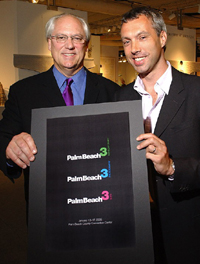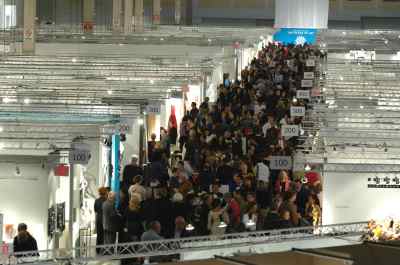 At the 2004 SOFA NEW YORK, Mark Lyman (at left) poses with dmg's Mark Carr to announce a partnership in PalmBeach3.
At the 2004 SOFA NEW YORK, Mark Lyman (at left) poses with dmg's Mark Carr to announce a partnership in PalmBeach3.
“I always knew that, at its very core, SOFA had to be about the art,” says Mark Lyman, founding director of the biggest art expo for work made from glass as well as other craft media. This year, the show’s founder will have a chance to reexamine his original vision after repurchasing the SOFA shows he had sold just three years earlier.
In 2006, international conference and event organizer dmg world media bought the SOFA shows from Lyman for an undisclosed sum (Lyman became vice-president of art antiques at dmg as part of the deal). In April 2009, Lyman teamed up with his former boss, Michael Franks (who had been chief operating officer of dmg), to reacquire the show in all its variations: SOFA CHICAGO, SOFA NEW YORK, and the newly launched SOFA WEST: Santa Fe. The duo’s jointly-owned venture, operated by a new entity called The Art Fair Company, is a leaner operation that Lyman hopes will bring SOFA back to its roots in subtle ways. With the number of dealers committed to being in Chicago this November hovering around 70 (as of early August), the 2009 SOFA CHICAGO looks to be a smaller event than in 2008, when 100 dealers exhibited, but it remains unchallenged as the most important event for sculpture and installations made from glass, ceramics, metal, textile, and wood.
Lyman’s SOFA journey began in 1983, when, as a practicing artist and professor at Washington University’s glass and sculpture program, he noticed how decentralized the market was for art made from craft media. With galleries spread around the United States, they were rarely taking part in the art fairs that were just becoming important hubs of the contemporary art scene at the time. Lyman debuted with an expo he called “New Art Forms” in the mid-1980s, and he rebranded his event at Navy Pier in Chicago as the “Sculptural Objects Fine Art expo,” or SOFA, in 1993. Growth has been steady, with the 2008 Chicago show drawing over 100 dealers from around the world, and over 34,000 visitors. The show has become increasingly international as dealers from countries with a less-developed market for artwork from glass and other “craft materials” seek access to the U.S. market.
 The 2008 SOFA CHICAGO brought 34,000 attendees and 100 exhibiting dealers over its three-day run. The photo is from the opening night preview.
The 2008 SOFA CHICAGO brought 34,000 attendees and 100 exhibiting dealers over its three-day run. The photo is from the opening night preview.
While SOFA seemed on an unstoppable growth curve, Lyman noticed that other art shows were growing even more quickly. He began to explore strategies to gain access to bigger resources. “Expression of Culture [the name of Lyman’s operating company at the time] had become very profitable,” he explains. “Unfortunately we were not doing as well as we could have to capitalize on that.”
In 2004, Lyman tested the waters when he partnered his SOFA brand with the PalmBeach3 art fair that had been purchased by dmg in 2001. (PalmBeach3 was bought back from dmg by its original owners David and Lee Ann Lester in December 2008, and the show was recently renamed Art Palm Beach).
In 2006 Lyman struck a full partnership with dmg world media, an international company that produces business and art events and publishes several magazines, and dmg ultimately acquired SOFA. Despite relinquishing his position as official owner, Lyman embraced his new role. His core team intact, he continued to run the SOFA shows, though with several new layers of bureaucratic oversight. When dmg added the SOFA shows to its portfolio, Lyman and his team were provided with a different level of business expertise; smoother cash flow, and new benefits such as corporate IT and human resources departments, says Lyman. But in 2009, dmg made the strategic decision to refocus their operation on business-to-business trade shows and the original founder saw an opportunity. Together with former dmg coo Franks, Lyman repurchased the show shortly thereafter.
“I always had a sense that, as a larger company, dmg didn’t get fully behind the original vision for the show,” says Lyman, “which is to keep pressing for art on the edge of the field, always digging for the deeper stories behind it all.” Lyman says that taking back control of the SOFA shows he created has given him a new freedom to make major decisions. “I won’t say that dmg held us back,” he says. “But now we can implement new projects without going upstairs through a long chain of OK’s, and that’s a huge difference. There is definitely more entrepreneurial excitement in my team to start new things.”
Topping his list of projects to tackle is SOFA WEST: Santa Fe, launched in June 2009. The debut last summer garnered mixed reviews by some galleries who reported slow sales despite the number of visitors; offical post-show numbers reported that 10,000 people attended the fair during its four-day run. “I think it was a combination of the bad economy, and Santa Fe’s relative unfamiliarity with these kinds of art objects,” says Scott Jacobson of New York’s Scott Jacobson Gallery (formerly Leo Kaplan Modern). “Sales were probably what I expected them to be, but certainly not what I had hoped them to be.” Citing the massive turnout and embrace of local officials, however, Lyman considers the event a success. “Our outlook is very bright,” he says about SOFA: Santa Fe. “We’ll definitely be back next year.”
Looking ahead to SOFA CHICAGO, Lyman acknowledges the difficult climate for selling art but remains upbeat. The final tally of dealers exhibiting was still to be determined three months before opening night of SOFA CHICAGO 2009, but the trend clearly indicates a smaller show. “All the big hitters will be here,” he says. “It’s the little guys you have to worry about.”
Finances aside, the SOFA founder is proud to be back at the helm of the most important expo for glass art. “The field has grown concurrently with SOFA, and I do believe that SOFA has fostered that growth,” says Lyman. “When you gather together a group of like-minded entities like this, only good things can happen.”
—Brett Nuckles


